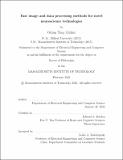| dc.contributor.advisor | Boyden, Edward S. | |
| dc.contributor.author | Çeliker, Orhan Tunç | |
| dc.date.accessioned | 2022-06-15T13:12:49Z | |
| dc.date.available | 2022-06-15T13:12:49Z | |
| dc.date.issued | 2022-02 | |
| dc.date.submitted | 2022-03-04T20:47:40.841Z | |
| dc.identifier.uri | https://hdl.handle.net/1721.1/143327 | |
| dc.description.abstract | The nematode C. elegans, a transparent animal with 302 neurons, is a suitable model organism for whole-brain measurement of nervous activity. However, under panneuronal labeling, it is difficult to resolve the identity of the neurons by shape or location alone. We propose a fluorescent in situ hybridization (FISH) based pipeline for reading out gene expression from neurons. Using optimization methods, we select a compact set of genes that provide enough information to distinguish every neighboring pair of neurons in the nervous system. We show that we can process volumetric images of live and fixed C. elegans to read out the gene expression patterns of each observed neuron and match it to their calcium indicator data. Separately, we also outline computational approaches to processing fluorescence data from novel fluorescent sensors. | |
| dc.publisher | Massachusetts Institute of Technology | |
| dc.rights | In Copyright - Educational Use Permitted | |
| dc.rights | Copyright MIT | |
| dc.rights.uri | http://rightsstatements.org/page/InC-EDU/1.0/ | |
| dc.title | Fast image and data processing methods for novel neuroscience technologies | |
| dc.type | Thesis | |
| dc.description.degree | Ph.D. | |
| dc.contributor.department | Massachusetts Institute of Technology. Department of Electrical Engineering and Computer Science | |
| mit.thesis.degree | Doctoral | |
| thesis.degree.name | Doctor of Philosophy | |
